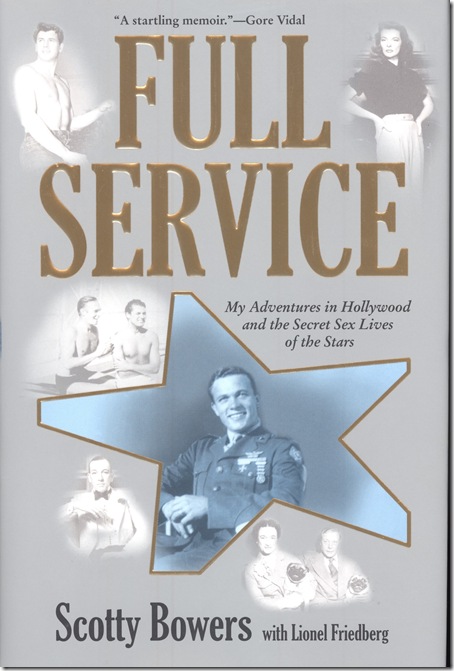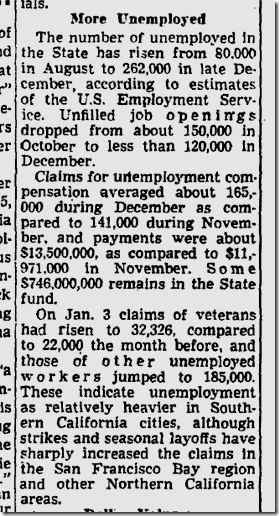
In case you just tuned in, I’m doing a little fact-checking as I go through Scotty Bowers’ “Full Service.” This will be fairly tedious except to a research drudge.
In our last installment, I didn’t do all that well on a word association test naming Bowers’ “dear and wonderful friends,” who are Conveniently Dead People Who Can’t Sue. I still haven’t figured out George was.
Finally, I have gotten to Page 1 (I warned you this would be tedious) in which Bowers (with co-author Lionel Friedberg) describes arriving in Los Angeles.
Fact-Checking “Full Service”: Part 1 | Part 2 | Part 3 | Part 4 | Part 5
Bowers, who says he was 23 in 1946, notes that cars hadn’t been made during the war and that production was increasing.
Gas stations were soon to become an iconic emblem on the landscape and were already springing up everywhere.
As we know from our research, the Richfield station at Hollywood Boulevard and Van Ness Avenue had been established for some time, presumably in the 1930s….
And right here was where I noticed that the shelves in one of the bookcases at the Daily Mirror HQ had pancaked on top of one another. Time for repairs.
Back to business.
Now this is kind of interesting – at least to me. Speaking of gas stations, Bowers says:
With their bustling latenight, brightly lit driveways and soda pop dispensing machines, they were ideal places for unemployed guys to hang around with their girlfriends, kill time, and meet up with friends.
This raises an interesting question, one that I hadn’t investigated very much, and that’s unemployment after World War II. As you may recall from a plot turn in “The Best Years of Our Lives,” employers were required rehire workers who had been in the military – with some exceptions. The LAPD, for example, had quite a few officers in the service and the blend of War Emergency officers and returning GIs (including future Chief William H. Parker) didn’t go smoothly.

Jan. 13, 1946: Unemployment in California rose 227% from August to December 1945. That is a staggering amount of people to put out of work.

Feb. 24, 1947: More grim news for veterans seeking jobs and housing.



I believe George is George Cukor.
LikeLike
As always, your fact-checking has turned up some really interesting items.
Re: the massive unemployment following the war – yes, times were incredibly tough for the returning vets as well as for the displaced Rosies of the defense industry. So many vets mustered out in California & decided to stay that it exacerbated the housing crunch — people were living in some very strange accomodations: attics, garages, sheds, anyplace they could get.
Strange times.
,,,and about that book: sleazy & apparently badly written as it is, I can’t wait to get a copy!
LikeLike
Did George get a discount for referring new clients Spence and Kate? Or at least extra Green Stamps?
LikeLike
Wish I could have been around to buy up a few of those Packard V-12 engines at that war surplus sale.
LikeLike
I’m reading the book now…
Some issues:
The author claimed he landed with the 1st wave of marines at Guadalcanal. He supposedly “dodged machine gun fire.” There was no opposition at this landing, the Japanese fled upon USMC arrival.
Also, after he left the gas station why would he have to become a bartender when he was “tricking” so many, and pimping for others. If this was true, he would have getting a lot of money and didn’t have to bartend.
He supposedly gave his gas station boss a “letter of resignation.” That doesn’t ring true, menial jobs like that are not that formal. Probably a “co-writer’s” embellishment.
LikeLike
This is fascinating series. I know I am replying long after this thread was active, but here I go. While the landing of Marines on the main Guadacanal island was lightly opposed (not unopposed), a few smaller nearby related islands (including Gavutu and Tanambogo) were also assaulted at the same time as part of the same campaign. Those were fiercely contested by the Japanese. Those two islands were assaulted by the 1st Marine Parachute Battalion acting as regular Marine infantry (they didn’t parachute it). Afterwards, the Paramarines moved to the main island and were part of the fierce fighting on Guadalcanal over the next 6 months. I looked over the image of the book cover at the top of the post. I can’t make out the shoulder patch (in WW2 the Marines did have unit-identifying patches on the left shoulder of the dress uniform). However, above his ribbons is clearly the marine parachutist badge. So he was a Paramarine. There were ballpark 800-1000 of them at Guadalcanal. That means it is plausible he was wounded during the invasion. No contradiction there. He might still be lying about his service, but this isn’t evidence of that. I’m really happy to be able to add something to all of this! 🙂
LikeLike
I don’t think the deceased judge really graduated from Los Angeles High School in 1808, however.
LikeLike
@Brian: It actually says 1898. Scanned microfilm of old papers from the linotype days doesn’t always reproduce well.
LikeLike